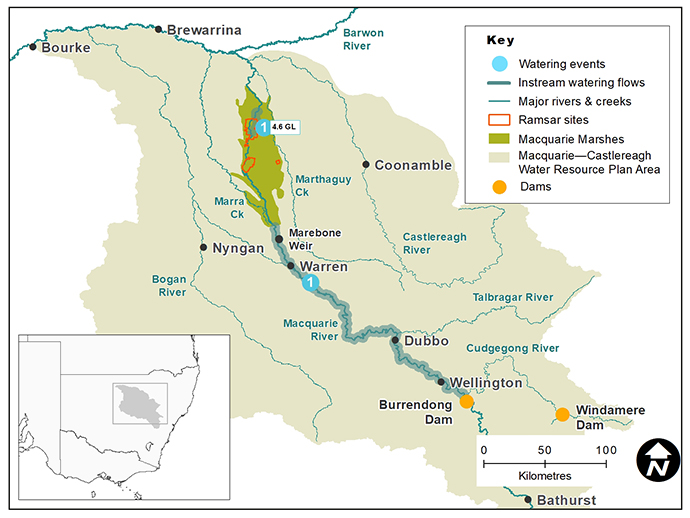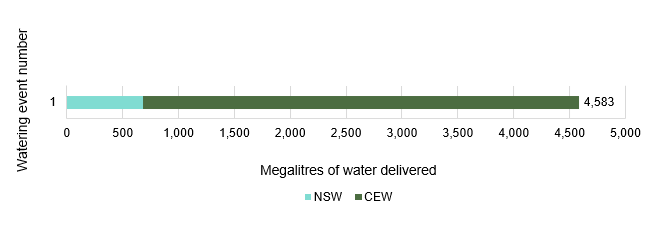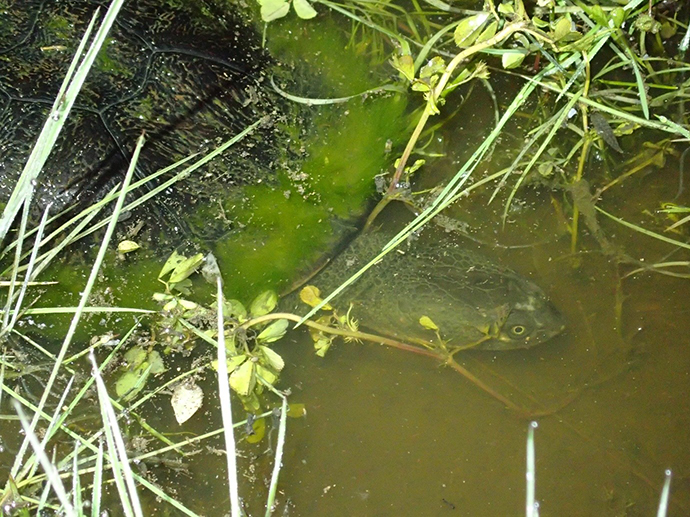The Macquarie valley covers more than 75,000 square kilometres in the north of New South Wales. It extends from the Blue Mountains to the Barwon River Plains, with major tributaries including the Cudgegong, Talbragar and Bell rivers. The valley is home to the iconic Macquarie Marshes – one of the largest semi-permanent wetland systems and colonial waterbird breeding sites in inland Australia.
A record drought
A record drought dominated conditions at the start of the 2019–20 water year, with all carryover water in licenced accounts quarantined by WaterNSW. This included 111.5 gigalitres from the NSW Environmental Water Allowance and general security held environmental water (HEW) held by New South Wales and the Commonwealth Environmental Water Holder (CEWH).
No water was available for active management, which meant the third year of the 3-year watering strategy set in 2016–17 was unable to be completed.
The prevailing resource availability scenario identified in the Macquarie–Castlereagh Catchment Annual Environmental Watering Priorities 2019–20 remained as ‘very dry’ in April 2020, with no water availability and an extremely dry landscape after 2.5 years of drought.
That situation started to change in January 2020 with rainfall resulting in runoff, followed by many events until 30 June 2020. The regulated river was again flowing through to the Barwon River and inundation of the core of the Macquarie Marshes occurred, including the northern Marshes reedbed which burnt in October 2019. Some supplementary HEW was used during this period to maximise flows to the Marshes and commence drought recovery. Some water-take restrictions were also applied by the NSW Government.
Watering aims
As identified in the Macquarie–Castlereagh Catchment Annual Environmental Watering Priorities 2019–20, watering aims for the water year were to avoid irretrievable loss of values and assets within the context of the drought.
To meet this objective, environmental water managers participated in:
- catchment drought planning to incorporate critical environmental demands into river operations
- actions to support aquatic fauna, such as freshwater turtles, stranded in dry drought refugia below Warren
- monitoring and analysis of possible actions to reduce the impact of the significant fish kill that occurred in early 2020, however interventions to deliver environmental water were not possible.
Water delivery
This bar chart and table provide a summary of 4583 megalitres of water for the environment use in the Macquarie–Castlereagh catchment during the 2019–20 watering year. Volumes are indicative only. Watering event numbers in the bar chart and table relate to location numbers marked on the map.
Notes: NSW = NSW licensed environmental water (general security and supplementary licences); CEW = Commonwealth licensed environmental water.
| Watering event number | Location | Outcomes | Start date | Finish |
|---|---|---|---|---|
| 1 | Mid-Macquarie River supplementary flow | Waterbirds Vegetation | 01 Dec 2019 | 01 Dec 2019 |
Outcomes
Relocation program
A collaborative partnership between the Department of Planning, Industry and Environment – Environment Energy and Science and the Department of Primary Industry – Fisheries tracked the persistence of water in 153 refuge pools between Warren and downstream of Marebone Weir. With rapidly declining pool numbers and water quality, a native fish and turtle rescue and relocation program occurred between September and October 2019. This unprecedented intervention secured a genetic insurance population of Murray cod and golden perch in hatcheries, and translocated freshwater turtles upstream.
Fish kill events
When rains returned to the Macquarie catchment in February 2020, the heavily sediment-laden runoff from a catchment with very low groundcover created two significant fish kill events due to hypoxic conditions (no, or low, oxygen in the water). Fish deaths were reported in the river from Wellington to Dubbo and downstream of Warren. No mitigation interventions were possible and thousands of mature fish and freshwater shrimp perished.
Potential for drought recovery
Since February 2020, there has been widespread ongoing rainfall and growing capacity for drought recovery actions leading into the 2020–21 water year. Many lessons have been learnt, including:
- managing risk over time with carryover – a 3-year plan was ineffective when dam operations do not secure water for meeting orders beyond 22 months
- as predominantly general security entitlement, the utility of current water for the environment assets to offset the effects of significant drought (during that drought) is limited
- the risk of fish kills following significant drought is very high, even in catchments where they do not typically occur.
The aims of the Macquarie–Castlereagh Catchment Annual Environmental Watering Priorities 2019–20 were achieved through what was a very dry year thanks to relief provided from natural river flows in early 2020.
Case study
In September 2019, as part of the drought response, flows in the Macquarie River were stopped at Warren to secure water for critical human needs.
With no flow in the river, 158 refuge pools below Warren weir began drying down, reducing available habitat, interrupting movement of water-dependent species and threatening the survival of resident wildlife.
The Department of Planning, Industry and Environment – Environment, Energy and Science (DPIE – EES) Water for the Environment Team worked with Department of Primary Industries – Fisheries (DPI – Fisheries) staff to identify longer lasting alternative habitat.
Together with volunteers, DPI – Fisheries focused on native fish relocations, while DPIE – EES turned their attention to the turtles.
Turtle relocation
The Macquarie River is home to 3 species of turtle – broad-shelled, Macquarie River and snake-necked turtles. Over 3 days 63 turtles were relocated to more reliable waterholes further upstream.
Species relocated included:
- 15 snake-necked turtles
- 5 Macquarie river turtles
- 43 broad-shelled turtles.
Since February 2020, the catchment has received significant rainfall, and flows were restored to the river below Warren. DPIE – EES, the Environmental Water Advisory Group and the Commonwealth Environmental Water Holder will work together to consider drought recovery in the river system over the next few years, which should benefit turtle species.


